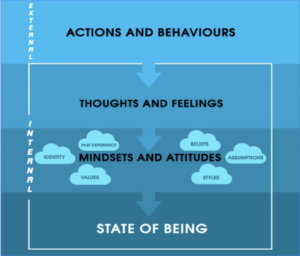Real Estate is an industry filled with vibrant intelligent people. From our work, we believe that one reason such people are attracted to work as realtors is that it’s a role that has such an intense level of engagement with other humans.
Realtors engage with their clients around a huge decision, at what is generally a stressful or tumultuous time, and need to mediate the emotions, needs and personalities of multiple people in essentially every interaction.
Even working with investor clients requires a pretty high level of people skills as you engage with someone around their values, risk tolerance, and livelihood.
This is why we’ve been working for over 10 years to support Realtors in learning high-level human skills to continue improving on their ability to serve diverse clients well. Today I want to explore the topic of getting in deeper with your clients to understand what’s really going on with them.
In our coach and leadership training program, we’ve developed the below framework as a way to understand what’s happening for people at a deeper level, and how that shows up on the surface.

The idea is that each level is motivated, explained, or based on the level below it.
Actions and Behaviours: this is what your clients, peers, team members, etc. are doing and saying. It is the easiest thing to see, and is a gateway into understanding what’s happening at lower levels. This is similar to the Stand in the SAM model from CNE courses. Actions and Behaviours are determined by:
Thoughts and Feelings: This is what’s going on in the person’s head – they might be aware of it and they might not be. Thoughts and feelings can change rapidly, or be deep ceded. They could be intentional strategies, plans, concerns, or unintentional fears, excitement, romanticizing. When you’re appealing to the right brain and left brain – this is all accessing the thoughts and feelings level. Area of concern and motivator in the SAM model can both be at the thoughts and feelings level. Thoughts and feelings are largely influenced by:
Mindsets and Attitudes: This includes values, beliefs, assumptions, identity, past experiences, deep habits, and styles of doing things. Mindset is the structure we create in our minds to support all of our decision making, it’s our world view. It takes a lot of skill to help people change their mindset (which should only be done when it’s in someone’s best interest) but being able to understand mindset, especially of your clients, can help you understand where they are basing their decisions, what their needs are, and how you can support them. Being able to have a favourable mindset is often determined by:
State of Being: This is inherently tied to someone’s wellness. It speaks to someone’s capacity as determined by their mental and physical health, their restedness, their self-care. When we see clients who are stressed and burnt out, it is often going to influence their state of being which will make it more challenging for them to have control over their mindset. Helping clients see this, stop fighting it, and make the decisions that can help them get back to a good state of being can make a huge difference in getting transactions done.
As real estate transactions become more complicated and balanced in power, and as clients make the decision about whether to work with a mass corporate tech company vs. an individual realtor, mastery of the human skills is becoming so important. We hope this framework is helpful in your work to understand your client’s needs. We should have a leadership and coach training program beginning this fall. Contact us if you’re curious about going really deep with this skills-building and mastering the human side of Real Estate.
